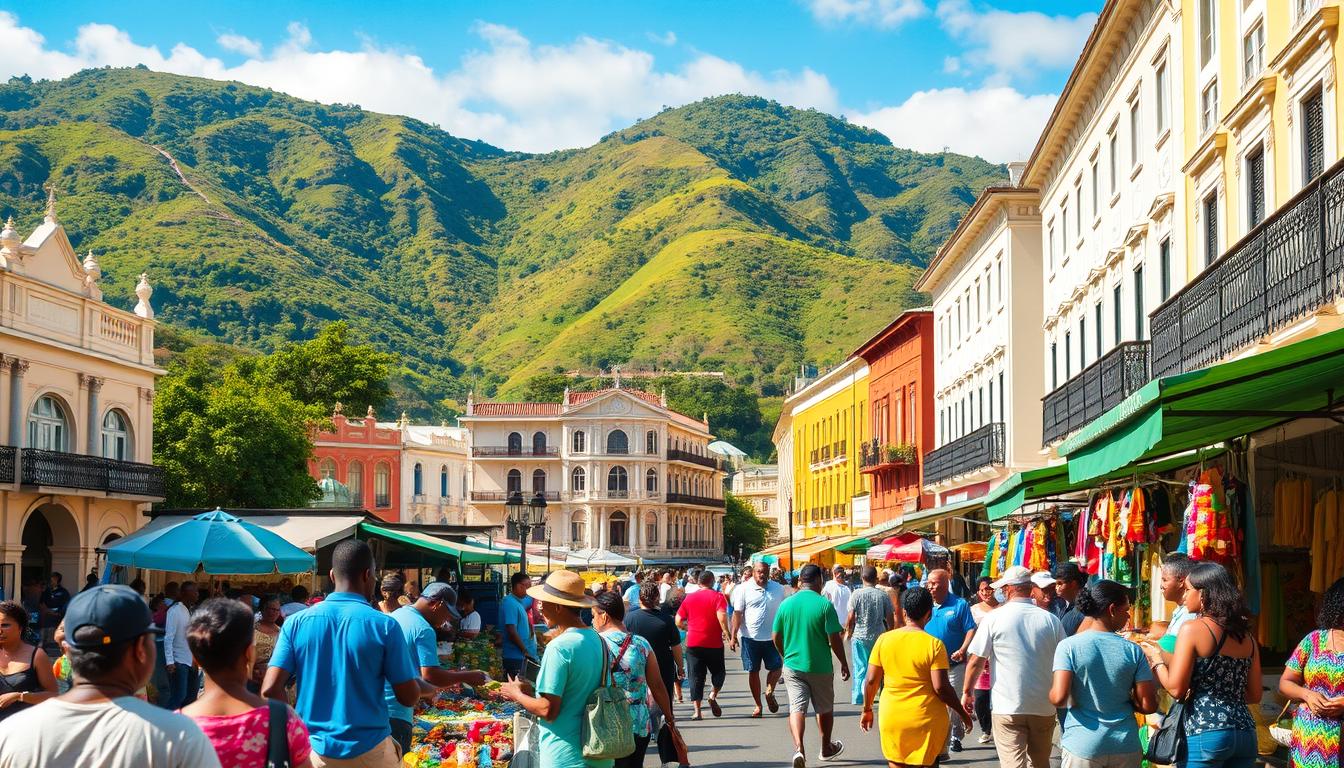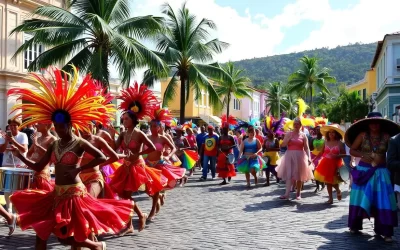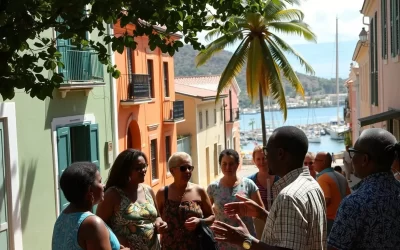✓ Accommodations ✓ Flights ✓ Rental Cars ✓ Tours & Activities
Did you know that the Eastern Caribbean dollar is the official currency of this stunning island? Yet, U.S. dollars are widely accepted in most places, making it easy for visitors to navigate transactions. Whether you’re relaxing at a beachfront resort or dining at a local restaurant, understanding the local currency and payment options can enhance your experience.
The Eastern Caribbean dollar has a fixed exchange rate with the U.S. dollar, so you’ll always know the value of your money. Credit cards are commonly used in hotels and tourist spots, but it’s wise to carry some cash for smaller vendors or markets. ATMs and banks are available across the island, ensuring you can access funds whenever needed.
This guide will help you prepare for your trip by providing tips on exchanging money, using cards, and understanding local etiquette. From resorts to restaurants, you’ll find practical advice to make your stay seamless and enjoyable. Let’s dive into everything you need to know about currencies and payments on this beautiful island.
St. Lucia: Ultimate Travelers Guide to Currencies & Payments
From cash to cards, the island offers a variety of payment methods for visitors. Whether you’re dining at a local restaurant or staying at a luxurious resort, knowing your options ensures a smooth experience. U.S. dollars are widely accepted, but the official currency is the Eastern Caribbean dollar. This dual system makes it easy for travelers to navigate transactions.
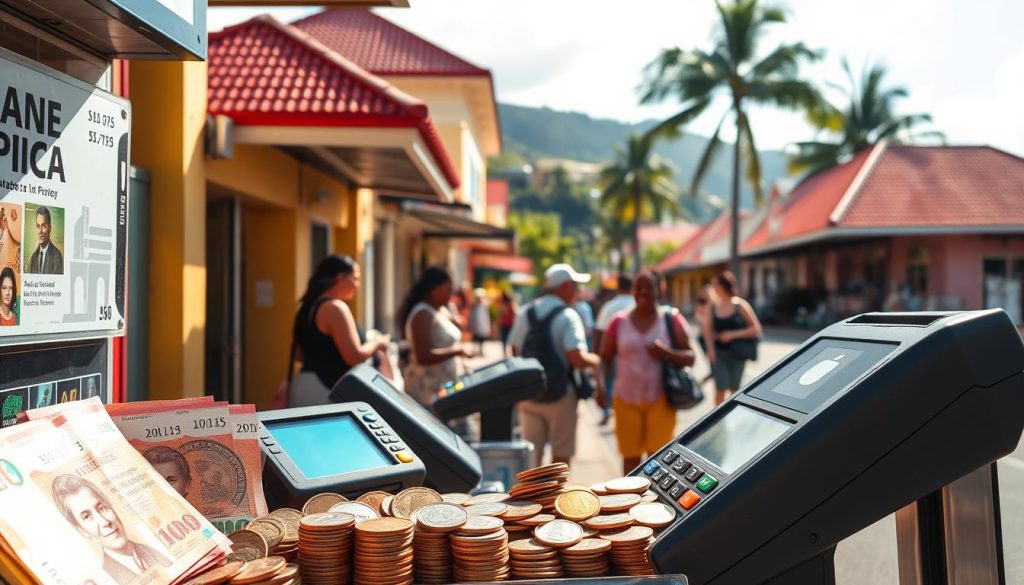
An Introduction to Payment Options on the Island
Most hotels, resorts, and tourist attractions accept credit cards, making it convenient for visitors. However, smaller vendors and local markets often prefer cash. It’s a good idea to carry both currencies to avoid any inconvenience. ATMs are available across the island, allowing you to withdraw Eastern Caribbean dollars as needed.
When using cards, always verify if there’s a charge for foreign transactions. Some establishments may add a small fee for card payments. This is especially common in smaller businesses. Keeping some cash on hand is always a smart move.
What You Need to Know Before You Arrive
Before your trip, check with your bank about international transaction fees. This will help you avoid unexpected charges. Upon arrival, consider exchanging a small amount of money to local currency for immediate needs. Many hotels and airports offer currency exchange services, but rates may vary.
“Always ask about the currency type before paying. Some vendors may quote prices in U.S. dollars but give change in Eastern Caribbean dollars.”
Here’s a quick guide to payment methods by establishment type:
| Establishment | Accepted Payment Methods |
|---|---|
| Hotels & Resorts | Credit cards, U.S. dollars, Eastern Caribbean dollars |
| Restaurants | Credit cards (major), cash (local currency preferred) |
| Local Markets | Cash (Eastern Caribbean dollars) |
| Tourist Attractions | Credit cards, U.S. dollars |
Understanding these options will help you plan your budget and enjoy your time on this beautiful island. With a mix of cash and cards, you’ll be ready for any situation.
Understanding St. Lucia’s Currency Landscape
Navigating the currency system in St. Lucia is simpler than you might think. The island uses a dual currency setup, making it easy for visitors to manage transactions. The official currency is the Eastern Caribbean dollar, but U.S. dollars are also widely accepted. This flexibility ensures a smooth experience whether you’re shopping at a local market or dining at a beachfront restaurant.
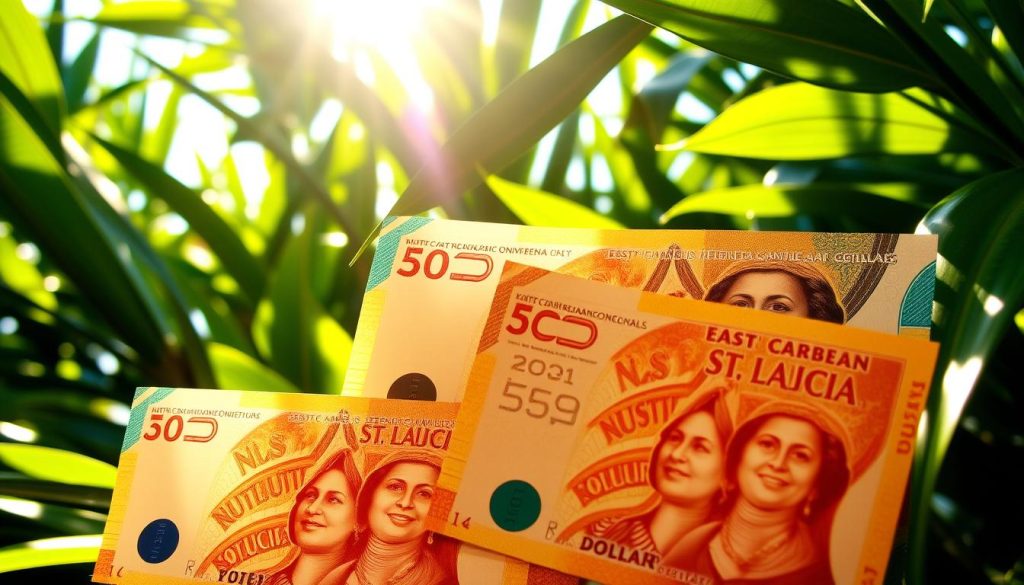
Eastern Caribbean Dollar Explained
The Eastern Caribbean dollar (EC$) has been the official currency since 1965. It’s used across several islands, including St. Lucia, and is divided into 100 cents. Coins come in denominations of 1, 2, 5, 10, and 25 cents, while bills are available in 5, 10, 20, 50, and 100 EC$. The currency is pegged to the U.S. dollar at a fixed rate of 1 USD = 2.70 EC$.
This fixed rate ensures stability, so you’ll always know the value of your money. For example, if you exchange $100 USD, you’ll receive 270 EC$. This makes budgeting straightforward and eliminates the stress of fluctuating exchange rates.
U.S. Dollar Acceptance and Its Nuances
U.S. dollars are widely accepted across the island, especially in tourist areas like hotels, resorts, and major attractions. However, there’s a catch: change is often given in Eastern Caribbean dollars. For instance, if you pay for a $10 meal with a $20 USD bill, you’ll likely receive your change in EC$.
Here’s a quick tip: always ask which currency is being used for pricing. Some vendors may quote prices in U.S. dollars but give change in local currency. This can affect your spending view, so it’s good to be prepared.
“Always carry small denominations of both currencies to avoid confusion during transactions.”
Here’s a breakdown of common scenarios:
| Scenario | Currency Used |
|---|---|
| Hotels & Resorts | U.S. dollars or EC$ |
| Local Markets | EC$ (cash preferred) |
| Street Vendors | EC$ or U.S. dollars |
| Tourist Attractions | U.S. dollars or EC$ |
Understanding these nuances will help you navigate the island’s currency landscape with ease. Whether you’re exchanging money at a bank or paying for a taxi, being informed ensures a hassle-free experience.
Navigating Money Exchanges and Banks
Planning your currency exchange strategy ensures a hassle-free trip. Knowing where to exchange money and understanding the best rates can save you time and effort. Whether you’re arriving at the airport or exploring the island, having a clear plan makes all the difference.
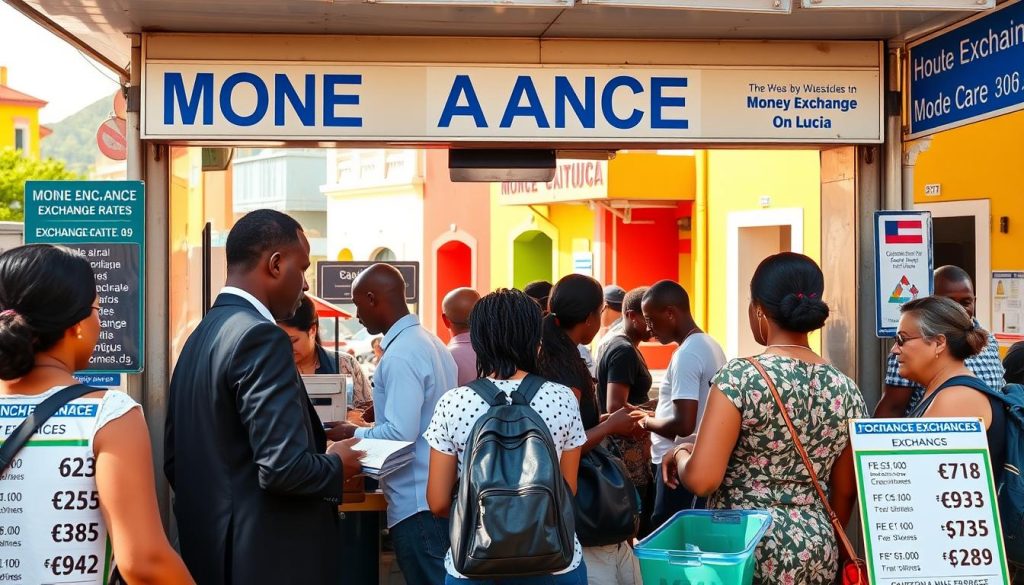
Best Practices for Exchanging Currency
Start by exchanging a small amount of money at the airport for immediate needs. This ensures you have local currency for taxis or snacks. For larger amounts, head to banks or authorized change bureaus in Castries. These places often offer better rates than hotels or small stores.
Always verify the exchange rate before making a transaction. Use online tools like XE Currency Converter to check real-time rates. This helps you avoid hidden fees or unfavorable rates. Remember, timing matters—exchange rates fluctuate throughout the day.
“Exchanging money at banks or bureaus ensures you get the best value for your dollar.”
Finding Banks and Change Bureaus
Banks in Castries, such as First National Bank and Bank of St. Lucia, are reliable options. They operate from 8:00 AM to 2:00 PM on weekdays, with extended hours on Fridays. Change bureaus are also available and often provide competitive rates.
Avoid exchanging money at hotels or small stores. They may charge higher fees or offer less favorable rates. Instead, use ATMs for convenience. Most ATMs dispense Eastern Caribbean dollars and are widely available across the island.
Here’s a quick comparison of exchange options:
| Option | Pros | Cons |
|---|---|---|
| Banks | Best rates, reliable | Limited hours |
| Change Bureaus | Competitive rates, convenient | May charge small fees |
| Hotels | Convenient | Higher fees, less favorable rates |
| ATMs | 24/7 access, local currency | Possible withdrawal fees |
By following these tips, you can navigate money exchanges with ease and focus on enjoying your trip.
Using Credit Cards and ATMs in St. Lucia
Exploring payment options on the island is easier than you might think. Whether you’re dining at a beachfront restaurant or staying at a luxurious resort, knowing how to use credit cards and ATMs ensures a smooth experience. Major cards like Visa and Mastercard are widely accepted in tourist areas, but it’s always good to have some cash on hand for smaller vendors.

Where Major Cards Are Widely Accepted
Credit cards are a convenient option for most transactions on the island. Hotels, resorts, and upscale restaurants typically accept major cards without issue. However, smaller businesses and local markets may prefer cash. Always ask about card acceptance before making a purchase to avoid surprises.
When using your card, be aware of potential foreign transaction fees. Some banks charge a small percentage for international use. Checking with your bank before your trip can help you plan accordingly. Additionally, notify your bank of your travel dates to avoid any security blocks on your card.
Tips on Locating Reliable ATMs
ATMs are widely available in key areas like Castries, Soufrière, Rodney Bay, and Vieux Fort. These machines dispense cash in Eastern Caribbean dollars, which is useful for smaller transactions. Always verify the ATM’s fees and withdrawal limits before using it to avoid unexpected charges.
For added security, use ATMs located inside banks or well-lit areas. Avoid standalone machines in remote locations. Planning ahead ensures you have enough cash for areas where cards may not be accepted, such as rural markets or street vendors.
“Always carry a mix of cash and cards to handle any situation during your stay.”
Here’s a quick guide to using ATMs and credit cards:
| Location | Payment Options |
|---|---|
| Hotels & Resorts | Credit cards, Eastern Caribbean dollars |
| Restaurants | Credit cards (major), cash (local currency preferred) |
| Local Markets | Cash (Eastern Caribbean dollars) |
| ATMs | Eastern Caribbean dollars only |
By following these tips, you can confidently navigate the island’s payment systems. Whether you’re relaxing on the beach or exploring local markets, having the right payment method ensures a hassle-free experience.
Managing Cash and Payment Options
Handling cash transactions during your trip ensures a smooth experience. While credit cards are widely accepted in many places, cash remains essential for smaller vendors and local markets. Knowing how to manage your money effectively can make your stay more enjoyable and stress-free.
Why Cash is Essential
Carrying local currency, the Eastern Caribbean dollar, is crucial for seamless payments. Many small businesses, street vendors, and rural markets prefer cash over cards. This is especially true in areas where card machines are unavailable or unreliable.
Having cash on hand also helps you avoid foreign transaction fees that some cards may charge. It’s a good idea to exchange a small amount of money upon arrival for immediate needs like taxis or snacks.
Tips for Handling Cash Safely
When paying in cash, always verify the amount you’re giving and the change you receive. Some vendors may quote prices in U.S. dollars but give change in local currency. This can lead to confusion if you’re not paying attention.
Here’s a quick tip: carry small denominations of both currencies. This makes transactions easier and reduces the risk of overpaying. For added security, avoid displaying large amounts of cash in public places.
“Always count your change carefully to ensure you’re receiving the correct amount in the right currency.”
Budgeting and Cash Reserve
Plan your daily expenses and set aside a cash reserve for incidental payments. This includes tips, small purchases, or unexpected costs. Using ATMs sparingly can help you avoid withdrawal fees, so withdraw larger amounts when necessary.
Here’s a breakdown of common scenarios where cash is preferred:
| Scenario | Preferred Payment Method |
|---|---|
| Local Markets | Cash (Eastern Caribbean dollars) |
| Street Vendors | Cash (local currency preferred) |
| Small Shops | Cash (Eastern Caribbean dollars) |
| Public Transportation | Cash (local currency) |
By following these tips, you can confidently manage your cash and enjoy a hassle-free trip. Whether you’re exploring local markets or dining at a beachfront restaurant, being prepared ensures a smooth experience.
Planning Your Budget: Costs and Service Charges
Budgeting for your trip is easier when you know what to expect in terms of costs and fees. From dining at a local restaurant to staying at a luxurious resort, understanding taxes and service charges ensures you won’t face surprises. Here’s how to plan your expenses wisely.
Understanding VAT and Service Charges at Hotels and Restaurants
Hotels and restaurants often include a 10% VAT and a 10% service charge in your bill. These fees are usually added automatically, so check your receipt to confirm. For example, a $100 meal might cost $120 after taxes and service charges.
At resorts, these charges are common, but smaller local eateries may not include them. Always ask if taxes and service fees are included to avoid confusion. This helps you budget accurately and avoid overspending.
Estimating Daily Expenses and Fare Tips
Daily costs can vary depending on your activities. Here’s a breakdown of common expenses:
- Accommodation: A standard hotel room costs $90 to $400 per night, while all-inclusive resorts range from $130 to $600.
- Dining: Local meals cost $5 to $15, while high-end dinners can exceed $30.
- Transportation: Taxi fares start at $20, and bus rides cost less than $2.
For transportation, always confirm fares before starting your journey. Taxis often charge fixed rates, but it’s good to ask upfront. Buses are a budget-friendly option, especially for short trips.
“Plan for incidental expenses like tips and small purchases to avoid running out of cash.”
Here’s a quick guide to budgeting for different activities:
| Activity | Estimated Cost |
|---|---|
| Hotel Stay | $90 – $600 per night |
| Local Meal | $5 – $15 |
| Taxi Ride | $20 – $50 |
| Bus Fare | Less than $2 |
By planning ahead, you can enjoy your trip without worrying about unexpected costs. Whether you’re relaxing on the beach or exploring the island, smart budgeting ensures a stress-free experience.
Tipping and Local Payment Etiquette
Understanding tipping customs in St. Lucia can enhance your travel experience. Tipping is discretionary but appreciated, reflecting gratitude for excellent service. Whether you’re dining at a restaurant or staying at a hotel, knowing the norms ensures you respect local culture.
Customary Tipping Guidelines for Various Services
In most places, a tip of 10% to 12% is standard. For example, at restaurants, a service charge of 10% is often included in the bill. If not, leaving an additional 10% is appreciated. At hotels, tipping housekeeping staff $1 to $2 per day is common.
For taxi drivers, rounding up the fare or adding 10% is a kind gesture. At spas, a 10% to 15% tip is customary for exceptional service. Always check your bill to see if a service charge is already included.
“When in doubt, ask if tipping is expected. It’s better to clarify than to assume.”
Some all-inclusive resorts may discourage tipping, so it’s wise to check their policy. In local markets or smaller establishments, tipping isn’t mandatory but is always welcomed for outstanding service.
Here’s a quick guide to tipping by establishment:
| Establishment | Suggested Tip |
|---|---|
| Restaurants | 10% (if not included) |
| Hotels | $1-$2 per day for housekeeping |
| Taxis | Round up or add 10% |
| Spas | 10%-15% |
By following these guidelines, you’ll navigate tipping with ease and show appreciation for the excellent service you receive. This small gesture can make a big difference in your interactions with locals.
Practical Money Tips for First-Time Visitors
Managing your money wisely can make your trip to this beautiful island stress-free. Whether you’re exploring local markets or dining at a hotel, understanding payment habits ensures a smooth experience. Here are some actionable tips to help you navigate transactions with ease.
Avoiding Currency Confusion with Local Vendors
When dealing with vendors, always ask which currency they accept. Some may quote prices in U.S. dollars but give change in Eastern Caribbean dollars. This can lead to confusion if you’re not paying attention.
Here’s a quick tip: carry small denominations of both currencies. This makes transactions easier and reduces the risk of overpaying. For example, if you’re buying souvenirs at a market, confirm the currency before handing over cash.
“Always verify the currency type before paying to avoid unexpected charges.”
Smart Payment Strategies for a Smooth Trip
Divide your funds between cash and cards for flexibility. Major cards are widely accepted at hotels and tourist spots, but smaller vendors often prefer cash. This ensures you’re prepared for any situation.
Use mobile apps or currency converters to check real-time rates. This helps you make sure you’re getting a fair deal. For instance, apps like XE Currency Converter can be a lifesaver when exchanging money.
Here’s a breakdown of smart payment strategies:
| Scenario | Best Payment Method |
|---|---|
| Hotels & Resorts | Credit cards or U.S. dollars |
| Local Markets | Cash (Eastern Caribbean dollars) |
| Taxi Rides | Cash (confirm fare in advance) |
| Tourist Attractions | Credit cards or U.S. dollars |
By following these tips, you’ll enjoy a hassle-free trip and focus on the beauty of the island. Whether you’re relaxing on the beach or exploring local culture, being prepared ensures a memorable experience.
Conclusion
Understanding how to handle money during your visit ensures a smooth and enjoyable experience. The official currency is the Eastern Caribbean dollar, but U.S. dollars are widely accepted in most tourist areas. This dual system makes transactions convenient for travelers.
For the best experience, carry a mix of cash and cards. Use ATMs for local currency and make sure to check for foreign transaction fees on cards. Smaller vendors and markets often prefer cash, so having some on hand is a smart move.
By following these tips, you’ll navigate payments with ease and focus on enjoying your travel. Whether dining at a restaurant or exploring the island, being prepared ensures a stress-free trip. Thank you for joining this guide, and we hope it helps you make the most of your visit!
The above is subject to change.
Check back often to TRAVEL.COM for the latest travel tips and deals.
